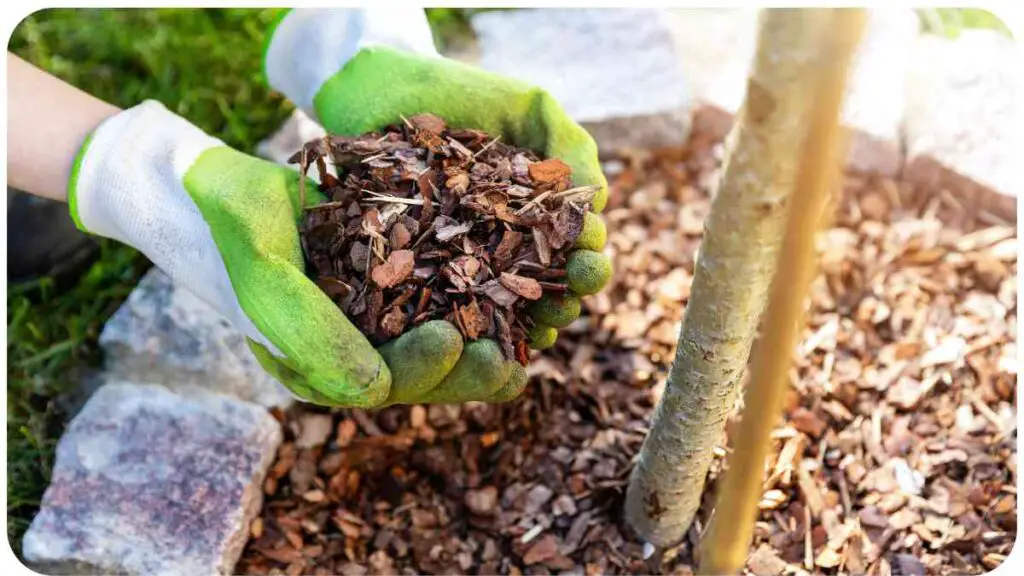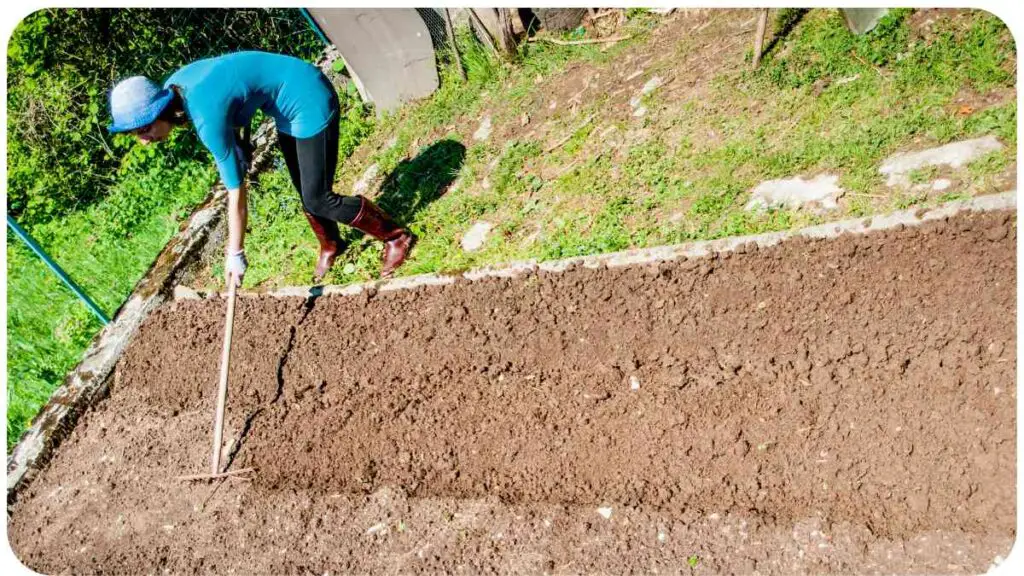Welcome to our comprehensive guide on achieving even mulch distribution in your garden beds. If you’ve ever dealt with patchy mulch, you know how frustrating and unsightly it can be.
In this article, we will delve into the importance of proper mulch distribution, step-by-step instructions, expert tips, and real-world case studies to help you maintain a lush and healthy garden.
| Takeaway |
|---|
| Proper mulch distribution enhances garden health and aesthetics. |
| Assess your garden’s needs and select the right mulch material. |
| Use the correct tools and techniques for even mulch application. |
| Avoid common mistakes like over-mulching and neglecting weed control. |
| Regularly maintain mulch to keep your garden thriving year-round. |
2. The Importance of Proper Mulch Distribution
Mulch isn’t just about aesthetics; it plays a crucial role in the health and vitality of your garden. When applied evenly, mulch helps retain moisture, suppresses weeds, regulates soil temperature, and improves soil quality. But achieving these benefits depends on how well you distribute your mulch.
Enhance your lawn’s beauty year-round with essential tips for a lush and vibrant green space. Discover expert advice to keep your lawn healthy and thriving.
Table 2.1: Benefits of Proper Mulch Distribution
| Benefit | Description |
| Moisture Retention | Keeps soil consistently moist |
| Weed Suppression | Prevents weed growth |
| Soil Temperature | Regulates soil temperature |
| Soil Improvement | Enhances soil structure and fertility |
| Plant Protection | Shields plants from harsh weather and pests |
3. Assessing Your Mulch Needs

Before diving into mulch distribution, you must assess your garden’s specific requirements. Consider factors such as the type of plants, soil composition, and climate conditions. This ensures you choose the right mulch material and quantity.
Table 3.1: Assessing Your Mulch Needs
| Factor | Considerations |
| Plant Types | Identify the types of plants in your garden |
| Soil Type | Determine your soil’s composition |
| Climate | Consider your local climate and weather patterns |
| Mulch Material | Select mulch material based on plant and soil needs |
Table 3.2: Common Mulch Materials
| Material | Description |
| Organic Mulches | Derived from natural sources, decompose over time |
| – Wood Chips | Excellent for moisture retention and weed control |
| – Straw | Ideal for vegetable gardens, decomposes quickly |
| – Bark Mulch | Long-lasting, adds a polished look to beds |
| Inorganic Mulches | Don’t decompose, provide long-term weed control |
| – Gravel | Suitable for xeriscaping, improves drainage |
| – Landscape Fabric | Prevents weed growth, retains moisture |
4. Tools and Equipment You’ll Need
Gathering the right tools and equipment is essential for achieving even mulch distribution. Here’s a list of items you’ll need:
Dive into the world of sustainable outdoor living with insights on creating a beautiful eco-friendly space. Explore practices that contribute to both aesthetics and environmental friendliness.
Table 4.1: Tools and Equipment
| Tool/Equipment | Description |
| Wheelbarrow | For transporting mulch to garden beds |
| Shovel | Helps with scooping and spreading mulch |
| Rake | Levels and smooths out the mulch surface |
| Garden Gloves | Protects hands from splinters and blisters |
| Mulch Spreader | Ensures even distribution of mulch |
| Watering Can/Hose | Used for watering beds after mulch application |
Now that you’ve gathered your tools and assessed your garden’s needs let’s move on to preparing your garden beds for mulching.
5. Preparing Your Garden Beds

To achieve even mulch distribution, it’s crucial to prepare your garden beds properly. Start by clearing any debris, weeds, or old mulch from the area. A clean slate ensures that your new mulch layer is uniform and effective.
Table 5.1: Steps for Preparing Garden Beds
| Step | Description |
| Clear Debris | Remove leaves, sticks, and old mulch |
| Weed Removal | Pull out any existing weeds |
| Soil Leveling | Ensure the soil surface is even and smooth |
| Edging | Define the edges of your garden beds |
Table 7.1: Step-by-Step Guide to Applying Mulch
| Step | Description |
| Evenly Spreading Mulch | Spread a layer of mulch 2-4 inches thick |
| Mulching Around Plants | Leave space around stems to prevent rot |
| Mulch Thickness | Maintain consistent thickness throughout |
| Edging Mulch | Tuck mulch tightly against bed edges |
| Mulch Depth | Check for even mulch depth across the bed |
8. Avoiding Common Mistakes
To ensure even mulch distribution, it’s essential to steer clear of common mistakes that can lead to patchy mulch and unhealthy garden beds.
Uncover the secrets of successful landscape transformations in The Ultimate Guide to Landscape Renovation. Learn essential factors for a successful outdoor makeover.
8.1. Over-Mulching
Applying too much mulch can suffocate plant roots and create a water-resistant barrier. It’s crucial to find the right balance to avoid this issue.
Table 8.1: Signs of Over-Mulching
| Sign | Description |
| Root Suffocation | Plants may struggle to access oxygen and nutrients |
| Fungus Growth | Excess moisture can lead to fungal problems |
| Surface Compaction | Hardened mulch can repel water |
8.2. Neglecting Weed Control
Proper mulch distribution is an excellent weed deterrent, but neglecting weed control can lead to patchy areas where weeds take root.
Table 8.2: Weed Control Tips
| Tip | Description |
| Weed Removal | Remove weeds before applying mulch |
| Weed Barrier | Use landscape fabric or newspaper beneath mulch |
| Mulch Thickness | Maintain sufficient mulch thickness to suppress |
8.3. Watering Considerations
Overzealous watering or inconsistent watering can impact mulch distribution and its effectiveness. Ensure a balanced watering routine.
Table 8.3: Watering Tips
| Tip | Description |
| Deep Watering | Encourage deep root growth with thorough watering |
| Mulch Moisture | Monitor mulch moisture and adjust watering as needed |
Now that you’re aware of these pitfalls, let’s discuss how to maintain your mulch over time.
9. Maintaining Mulch Over Time
Proper mulch maintenance is essential to keep your garden beds healthy and attractive throughout the seasons.
Elevate your outdoor experience with 15 secrets to designing a captivating living space. Discover expert tips for creating an inviting and functional outdoor environment.
9.1. Seasonal Adjustments
Different seasons may require adjustments to your mulch layer to accommodate changing weather conditions.
Table 9.1: Seasonal Mulch Adjustments
| Season | Mulch Adjustment |
| Spring | Refresh mulch and address any compaction |
| Summer | Monitor moisture and replenish mulch as needed |
| Fall | Add a thicker layer for insulation |
| Winter | Protect plants with mulch from harsh winter winds |
9.2. Renewing Mulch
Over time, mulch breaks down and loses its effectiveness. Regularly renewing your mulch ensures that it continues to provide benefits.
Table 9.2: Signs It’s Time to Renew Mulch
| Sign | Description |
| Mulch Decomposition | Noticeable deterioration of mulch material |
| Weed Growth | An increase in weed activity |
| Uneven Mulch Depth | Areas with reduced mulch thickness |
As you can see, maintaining mulch is an ongoing process that requires attention and care. By following these guidelines, you can ensure your garden beds remain vibrant and healthy year-round.
Continue reading for a deeper dive into the benefits of proper mulch distribution and troubleshooting uneven mulch.
Table 10.1: Benefits of Proper Mulch Distribution
| Benefit | Description |
| Moisture Retention | Keeps soil consistently moist |
| Weed Suppression | Prevents weed growth |
| Soil Temperature | Regulates soil temperature |
| Soil Improvement | Enhances soil structure and fertility |
| Plant Protection | Shields plants from harsh weather and pests |
11. Troubleshooting Uneven Mulch
Despite your best efforts, you may encounter uneven mulch distribution in your garden beds. Let’s explore some common issues and how to address them.
Explore creative ideas for water-wise landscaping in Xeriscaping Ideas. Learn innovative ways to save water while maintaining a beautiful and sustainable garden.
Table 11.1: Troubleshooting Uneven Mulch
| Issue | Description |
| Wind Redistribution | Wind can blow mulch away; consider windbreaks |
| Rain Erosion | Heavy rain can wash mulch downhill; repair slopes |
| Animal Activity | Animals may dig or scatter mulch; use deterrents |
| Settling Mulch | Mulch may naturally settle; top up as needed |
12. Expert Tips for Mulch Distribution
Drawing from years of experience, here are some expert tips to ensure your mulch distribution is top-notch:
Table 12.1: Expert Tips for Mulch Distribution
| Tip | Description |
| Mulch Selection | Match mulch type to your specific plant needs |
| Uniform Thickness | Maintain a consistent mulch layer thickness |
| Edge Maintenance | Regularly redefine bed edges for a polished look |
| Watering Technique | Water deeply and consistently to support mulch |
| Seasonal Assessment | Adjust mulch thickness according to the season |
13. Case Studies: Real-World Success Stories
Let’s take a look at some real-world examples of gardeners who have achieved outstanding results through proper mulch distribution.
Table 13.1: Case Studies
| Case Study | Description |
| Sarah’s Vegetable Garden | Sarah used straw mulch to enhance moisture retention and weed suppression in her vegetable garden. As a result, her tomato and pepper plants thrived, and weeding became a breeze. |
| John’s Flower Beds | John applied wood chip mulch to his flower beds, creating an attractive and weed-free display. The mulch also kept the soil consistently cool, leading to vibrant blooms throughout the summer. |
| Maria’s Xeriscape | Maria opted for gravel mulch in her xeriscape garden, reducing water usage and creating a low-maintenance landscape. Her garden remained stunning even in arid conditions. |
14. Frequently Asked Questions (FAQs)
Let’s address some common questions about mulch distribution:
Table 14.1: FAQs
| Question | Answer |
| How thick should mulch be? | Mulch should be 2-4 inches thick for most applications. |
| Can I use newspaper as a weed barrier? | Yes, newspaper can be an effective weed barrier beneath mulch. |
| Should I remove old mulch before adding a new layer? | It’s recommended to remove some old mulch to prevent excessive buildup. |
15. Conclusion
In conclusion, achieving even mulch distribution in your garden beds is essential for maintaining a healthy and thriving garden. By assessing your needs, selecting the right mulch material, and following our step-by-step guide, you can prevent patchy mulch and enjoy the numerous benefits mulch provides.
Remember to monitor your garden’s condition, make seasonal adjustments, and renew mulch as needed. With these practices, you’ll have a garden that’s not only beautiful but also resilient and easy to maintain. Happy gardening!
Further Reading
Here are some additional resources to help you delve deeper into the world of mulch distribution:
- How to Mulch a Garden: This comprehensive guide offers detailed insights into mulching techniques and the benefits of mulching in your garden.
- 3 Tips for Mulching Around Trees and Shrubs: Learn valuable tips specifically tailored for mulching around trees and shrubs, ensuring their health and longevity.
- Mulching the Garden: Bob Vila’s article covers essential aspects of mulching and its impact on garden maintenance, offering practical advice for both beginners and experienced gardeners.
FAQs
How thick should mulch be for my garden?
Mulch should ideally be applied at a thickness of 2-4 inches. This depth helps with moisture retention, weed suppression, and temperature regulation.
Can I use newspaper as a weed barrier under mulch?
Yes, newspaper can be an effective weed barrier when placed under mulch. It helps prevent weed growth and decomposes over time, enriching the soil.
Should I remove old mulch before adding a new layer?
It’s advisable to remove some of the old mulch before applying a new layer. This prevents excessive mulch buildup, which can lead to issues like over-mulching.
What’s the best mulch material for flower beds?
The choice of mulch material for flower beds depends on your specific needs and aesthetics. Popular options include wood chips for a natural look and straw for vegetable gardens.
How often should I renew the mulch in my garden beds?
Mulch should be renewed as needed, typically on an annual basis. Signs that it’s time to renew mulch include decomposition, weed growth, and uneven mulch depth.

Hi! My name is Hellen James, and I’m a landscape designer in Los Angeles. I’ve been working with homeowners and businesses to help them improve the look of their properties for over 10 years.


